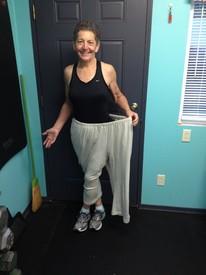We are pleased to announce that on March 4, 2025, an updated Rich Text Editor will be introduced in the MyFitnessPal Community. To learn more about the upcoming changes, please click here. We look forward to sharing this new feature with you!
Paying Extra for a Heart Rate Monitor - Is it really worth it? (Fitness Band)

erinblack00
Posts: 1 Member
Hello!
I am looking to buy a new fitness tracker band and am having a hard time deciding if I should shell out the extra cash to pay for a band that has a built-in heart rate monitor. I don't know if it is really worth it? I will be using it mainly for steps, distance and swimming. I don't have heart or health issues. I just don't want to waste money if it's more "just kinda nice to know" than "gives you much better accurate readings/workout". Any help is appreciated!
Bio: F / 28
I am looking to buy a new fitness tracker band and am having a hard time deciding if I should shell out the extra cash to pay for a band that has a built-in heart rate monitor. I don't know if it is really worth it? I will be using it mainly for steps, distance and swimming. I don't have heart or health issues. I just don't want to waste money if it's more "just kinda nice to know" than "gives you much better accurate readings/workout". Any help is appreciated!
Bio: F / 28
0
Replies
-
I think it would be better to go for an actual heart rate monitor (one with a watch, and band that goes around your chest) rather than a fitness band with a heart rate monitor built in that you have to tighten around the wrist. I feel like it would be more accurate. I could be wrong.1
-
And I mean as far as tracking an exercise! The fitness bands are pretty cool, and toss up between which one is more accurate as far as step counting goes.0
-
From my research most of those trackers suck as heart rate monitors. Sounds the chest strap is the way to go for more accurate readings.1
-
I love the Fitbits with the HR tracker for all-day tracking. However, the heart rate monitors with the chest strap are way more accurate for workouts. I don't do much cardio, so I prefer the Fitbit's all-day tracking.2
-
I have had a Polar HRM since about 2012 and I love it. It gives a much more accurate reading for tracking exercise calories. I will say that if you have been relying on MFP numbers for exercise, you might be disappointed with the burn, lol.. as it's guaranteed to be waaaaaay lower than the predictors here or on machines at the gym, but more accurate.
That and I like having the stability of knowing how much I burned doing exercise in case I have a "hungry day".
I don't wear mine all day, only during exercise or if I am going to be walking all day. I like that I can pause it at any point and resume as well. Makes it nice for outings to the zoo, wilderness hikes, that sort of thing.0 -
I don't do cardio so it wasn't worth it for me. I just wanted to track steps and increase NEAT.
Lately I've WANTED to do cardio. Well, I don't want to. But I should. I am wondering if the heart rate monitor will make it more...fun? No. Probably not. Yucky.0 -
For walking, a heart rate sensor is not worth paying extra for.0
-
It depends on you fitness goals. If you do zone training, you need to be able to monitor your heart rate. Also, if you are not sure if you are pushing yourself enough or if you are over doing it you need a heart rate monitor. If you just want to maintain your current fitness level you should be at 70 percent of your maximum heart rate and a heart rate monitor would help you track it. It can give you great data, and I couldn't be without one.0
-
It's not worth it in my opinion, and may give you artificially higher burns when your heart rate increases for non exercise reasons (coffee, stress, excitement...etc) or during any other exercise that isn't steady state cardio. If you are doing zone training, I would get a separate heart rate strap and only use it during your zone training. Other than that, none of it is necessary. A step-based band is more than enough.
If heart rate during swimming is important to you, keep in mind that most chest straps that use bluetooth will not work under water even if waterproof. You will want a strap and a fitness band than support 5 kHz transmission. Otherwise I would just manually log the swimming.0 -
I love my Wahoo fitness HRM that connects to a wide range of apps on your phone, including the free Wahoo Fitness app.0
-
HRMs are good for training not tracking. If you plan to work out with the purpose of getting faster, then an HRM can help (not necessary, but it does offer some different ways to train). If you goal is to count calories, don't waste your money. It is pointless (no matter what the marketing department puts on the box).2
-
I've never seen the point.the data is often misinterpreted because the HRM burn counts only for steady state cardio.0
-
In my experience they're neat gimmicks but you'll get bored of it sooner or later. They're really nothing special unless you have a specific use for them.0
-
My only exercise is step based, mainly walking. So a HR monitor would be a waste of time and dollars for me.
I started off with a fitbit zip, which worked great. I then wanted to upgrade to something that had sleep tracking and i could wear as a watch, so i went with the fitbit Alta (non hr model). I did consider the charge2, but the $250+ price tag and my gut feels and mistrust of wrist worn HR monitors swayed me toward the Alta.0 -
HRMs are good for training not tracking. If you plan to work out with the purpose of getting faster, then an HRM can help (not necessary, but it does offer some different ways to train). If you goal is to count calories, don't waste your money. It is pointless (no matter what the marketing department puts on the box).
I agree. I've had several HRMs and I wouldn't rely on any of them to tell me my calorie burn, but they do give a good indication of how much more I can put out.0 -
erinblack00 wrote: »Hello!
I am looking to buy a new fitness tracker band and am having a hard time deciding if I should shell out the extra cash to pay for a band that has a built-in heart rate monitor. I don't know if it is really worth it? I will be using it mainly for steps, distance and swimming. I don't have heart or health issues. I just don't want to waste money if it's more "just kinda nice to know" than "gives you much better accurate readings/workout". Any help is appreciated!
Bio: F / 28
Most people don't get any significant value from HR monitoring, regardless of how that's done.
The only useful data is your resting heart rate, which is an indicator of residual fitness.
Wrist with optical can have some issues of fit and skin tone, but in the main they're good enough for most people.
Given what you describe as your activities I wouldn't see any meaningful value.0 -
Save your money - not seeing any need or benefit to you from knowing your HR, which is all HRMs are actually good at.
They can be a great training aid/exercise aid for some, but that's a relatively small proportion of people.0 -
HRMs are good for training not tracking. If you plan to work out with the purpose of getting faster, then an HRM can help (not necessary, but it does offer some different ways to train). If you goal is to count calories, don't waste your money. It is pointless (no matter what the marketing department puts on the box).
Yep. They work better for training than tracking. The calorie burn calculations with my chest hrm weren't that much different than without. But it worked well for my half marathon training when I did my runs based on heart rate zone.0 -
HRMs are good for training not tracking. If you plan to work out with the purpose of getting faster, then an HRM can help (not necessary, but it does offer some different ways to train). If you goal is to count calories, don't waste your money. It is pointless (no matter what the marketing department puts on the box).
Completely agreed here. I use a wrist based one (tried a chest strap and found that I'd get lapses in output) for training. It's been accurate within 1-2 bpm from a counted carotid pulse, at least for me, but I have found that it needs to be very flat and very tight on my wrist to work right. I look at it in training and graphs after training to see where I was pushing hard, where I wasn't, and when I can actually push a lot harder than I am.
As far as calorie count, I don't even consider it at all. I found a working number of calories per mile running or bicycling that's aligns with the results I see on the scale at the measured calorie intake, and go with that. For lifting I don't worry about the calories burned that much during exercise. I just watch the scale trend and adjust.0 -
Jthanmyfitnesspal wrote: »I love my Wahoo fitness HRM that connects to a wide range of apps on your phone, including the free Wahoo Fitness app.
If you're looking for a chest band this I a second vote for the Wahoo.
If you're talking about wrist based integrated, YMMV and that's the bottom line. Certainly knowing what your RHR is, and being able to see how your HR jumps around through the day is interesting, but not extraordinarily meaningful.0 -
HRMs are good for training not tracking. If you plan to work out with the purpose of getting faster, then an HRM can help (not necessary, but it does offer some different ways to train). If you goal is to count calories, don't waste your money. It is pointless (no matter what the marketing department puts on the box).
This 100.
Worthy tool for improving training.
Counting calories, totally unnecessary.0 -
I have the charge HR and I don't ever pay attention to the heart rate on it during exercise. I find it not very accurate at all. When just doing cardio I have a Polar chest strap HR and use that just to estimate my calories burned. The only thing I really find my tracker helpful for is tracking my steps.0
-
HRMs are good for training not tracking. If you plan to work out with the purpose of getting faster, then an HRM can help (not necessary, but it does offer some different ways to train). If you goal is to count calories, don't waste your money. It is pointless (no matter what the marketing department puts on the box).
I have found HR-driven training to be very helpful and I recommend it to anybody. For each individual, you can monitor level of effort from HR and you can see how your fitness is improving over time as you can do more for the same HR. I prefer using a chest strap to monitor HR, but a wrist device could be acceptable.
WRT calorie estimates: all available methods are pretty crude. The HRM-based formula most people use is from this paper:
https://www.researchgate.net/publication/7777759_Prediction_of_energy_expenditure_from_heart_rate_monitoring_during_submaximal_exercise
The data show reasonable correlation with respiration analysis (the gold standard for calorie estimates), but also show significant variation from predicted values.
The same is true for all formulas, including the most common ones based on weight and distance. often used for running is
net kcals = (Body weight in pounds) x (0.63) x (Distance in miles)
This is from
http://www.indiacurry.com/weightloss/walkingrunningcalories.htm
Note that this doesn't include speed (supposedly, for walking the factor 0.63 ->0.30, for example). That's because when you run it faster, you run for less time, so it's supposed to work itself out.
For my most recent 5.1 mile run, the above formula gives 578kcals. The Wahoo fitness app uses the HR formula to give 738kcals. MFP (which uses a lower body weight as measured in light clothing in the morning) estimates the workout at 639kcals, close to the average of the other two.
So what's a person to do? Recognize that all these formulas are crude. Be conservative in eating back exercise calories, no matter what formula is used!1 -
Jthanmyfitnesspal wrote: »HRMs are good for training not tracking. If you plan to work out with the purpose of getting faster, then an HRM can help (not necessary, but it does offer some different ways to train). If you goal is to count calories, don't waste your money. It is pointless (no matter what the marketing department puts on the box).
I have found HR-driven training to be very helpful and I recommend it to anybody. For each individual, you can monitor level of effort from HR and you can see how your fitness is improving over time as you can do more for the same HR. I prefer using a chest strap to monitor HR, but a wrist device could be acceptable.
WRT calorie estimates: all available methods are pretty crude. The HRM-based formula most people use is from this paper:
https://www.researchgate.net/publication/7777759_Prediction_of_energy_expenditure_from_heart_rate_monitoring_during_submaximal_exercise
The data show reasonable correlation with respiration analysis (the gold standard for calorie estimates), but also show significant variation from predicted values.
The same is true for all formulas, including the most common ones based on weight and distance. often used for running is
net kcals = (Body weight in pounds) x (0.63) x (Distance in miles)
This is from
http://www.indiacurry.com/weightloss/walkingrunningcalories.htm
Note that this doesn't include speed (supposedly, for walking the factor 0.63 ->0.30, for example). That's because when you run it faster, you run for less time, so it's supposed to work itself out.
For my most recent 5.1 mile run, the above formula gives 578kcals. The Wahoo fitness app uses the HR formula to give 738kcals. MFP (which uses a lower body weight as measured in light clothing in the morning) estimates the workout at 639kcals, close to the average of the other two.
So what's a person to do? Recognize that all these formulas are crude. Be conservative in eating back exercise calories, no matter what formula is used!
To add to the confusion, because you can't see inside the calculator, You can't know if it's accounting for the TDEE of the added steps separately. Or the TDEE of being alive... another 100ish calories.
Proprietary formulas and estimation can be confusing and annoying and frustrating.0 -
stanmann571 wrote: »
To add to the confusion, because you can't see inside the calculator, You can't know if it's accounting for the TDEE of the added steps separately. Or the TDEE of being alive... another 100ish calories.
Proprietary formulas and estimation can be confusing and annoying and frustrating.
I just want to add that all the formulas I listened are purported to be calorie burn in addition to BMR. One thing not included (except maybe for MFP, which is "proprietary," as you note), is the increase in BMR caused by exercise.0 -
If you're interested in tracking your heart rate as a fitness metric I'd say it's worthwhile, if not save your money....0
-
I've always had a difficult time at keeping my pace at the conversational pace for training. My heart rate monitor is a constant reminder to slow it down.0
-
Jthanmyfitnesspal wrote: »HRMs are good for training not tracking. If you plan to work out with the purpose of getting faster, then an HRM can help (not necessary, but it does offer some different ways to train). If you goal is to count calories, don't waste your money. It is pointless (no matter what the marketing department puts on the box).
I have found HR-driven training to be very helpful and I recommend it to anybody. For each individual, you can monitor level of effort from HR and you can see how your fitness is improving over time as you can do more for the same HR. I prefer using a chest strap to monitor HR, but a wrist device could be acceptable.
WRT calorie estimates: all available methods are pretty crude. The HRM-based formula most people use is from this paper:
https://www.researchgate.net/publication/7777759_Prediction_of_energy_expenditure_from_heart_rate_monitoring_during_submaximal_exercise
The data show reasonable correlation with respiration analysis (the gold standard for calorie estimates), but also show significant variation from predicted values.
The same is true for all formulas, including the most common ones based on weight and distance. often used for running is
net kcals = (Body weight in pounds) x (0.63) x (Distance in miles)
This is from
http://www.indiacurry.com/weightloss/walkingrunningcalories.htm
Note that this doesn't include speed (supposedly, for walking the factor 0.63 ->0.30, for example). That's because when you run it faster, you run for less time, so it's supposed to work itself out.
For my most recent 5.1 mile run, the above formula gives 578kcals. The Wahoo fitness app uses the HR formula to give 738kcals. MFP (which uses a lower body weight as measured in light clothing in the morning) estimates the workout at 639kcals, close to the average of the other two.
So what's a person to do? Recognize that all these formulas are crude. Be conservative in eating back exercise calories, no matter what formula is used!
When I compare a good chest strap and Firstbeat's energy expenditure algorithm against a power meter, the HR based estimate is off by anywhere from 1 kCal to more than 40 %.0 -
stanmann571 wrote: »To add to the confusion, because you can't see inside the calculator, You can't know if it's accounting for the TDEE of the added steps separately. Or the TDEE of being alive... another 100ish calories.
Proprietary formulas and estimation can be confusing and annoying and frustrating.Jthanmyfitnesspal wrote: »I just want to add that all the formulas I listened are purported to be calorie burn in addition to BMR. One thing not included (except maybe for MFP, which is "proprietary," as you note), is the increase in BMR caused by exercise.
It's important to understand how your preferred source of calorie numbers works, whether it includes "just being alive" calories or not. You usually don't need its source code to know that.
For example: On a bike, I use a power meter to measure the amount and rate of energy I put into the bike. If I stay on the couch, it says zero.0 -
NorthCascades wrote: »For example: On a bike, I use a power meter to measure the amount and rate of energy I put into the bike. If I stay on the couch, it says zero.
We may have discussed this before, but: translating the power from your bike power meter to calories expended requires an efficiency factor that is pretty close to x4 (an efficiency of ~25%). But this number isn't the same for all riders and can vary even for a particular rider. I've seen the efficiency factor quoted as being between 20% and 25%, which translates to an uncertainty in calorie burn of +/- 10%.
Note: The fact that the efficiency factor is close to 4 makes the conversion from kJoul applied to kcals expended have a factor of near 1 (since 1kcal = 4.2kJoule). This leads people to sometimes think that they cycle with 100% efficiency but that is not the case.
A cycling power meter is still an incredible tool in that it determines your power output very accurately. If you combine this info with HRM and GPS data, you pretty much have everything you could possibly want to track your fitness level!0
This discussion has been closed.
Categories
- All Categories
- 1.4M Health, Wellness and Goals
- 394.3K Introduce Yourself
- 44K Getting Started
- 260.5K Health and Weight Loss
- 176.1K Food and Nutrition
- 47.5K Recipes
- 232.7K Fitness and Exercise
- 442 Sleep, Mindfulness and Overall Wellness
- 6.5K Goal: Maintaining Weight
- 8.6K Goal: Gaining Weight and Body Building
- 153.1K Motivation and Support
- 8.1K Challenges
- 1.3K Debate Club
- 96.4K Chit-Chat
- 2.5K Fun and Games
- 4K MyFitnessPal Information
- 16 News and Announcements
- 1.2K Feature Suggestions and Ideas
- 2.7K MyFitnessPal Tech Support Questions




















